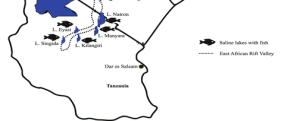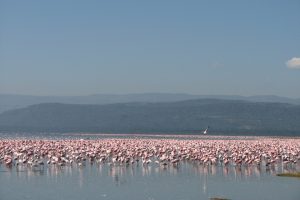The Tanzanian Saline Rift Valley Lakes (SRVLs) are shallow, soda-saline lakes formed within tectonic depressions of the East African Rift Valley. These lakes exhibit high salinity and alkalinity, supporting unique endemic fish species. Despite harsh conditions, they face ecological threats from invasive species like Nile tilapia and habitat degradation. The introduction of invasive species further disrupts the delicate balance of the Saline Rift Valley Lakes (SRVLs). Among them, Nile tilapia (Oreochromis niloticus) has rapidly established itself despite the lakes’ extreme salinity. Understanding its genetic connectivity and origins is crucial in assessing its impact on endemic fish species and formulating effective conservation strategies.
Scientists from Sokoine University of Agriculture are investigating the genetic connectivity and potential origins of Nile tilapia (Oreochromis niloticus) populations in the Tanzanian Saline Rift Valley Lakes (SRVLs). These lakes are shallow, soda-saline water bodies formed within tectonic depressions of the East African Rift Valley. They are characterized by high salinity and alkalinity, supporting unique endemic fish species adapted to extreme environmental conditions.

Despite these harsh conditions, SRVL ecosystems face increasing ecological threats, including habitat degradation and invasive species introductions. Among these, Nile tilapia has successfully established itself in these extreme saline environments, disrupting the delicate ecological balance of the lakes. Understanding the genetic connectivity and origins of these non-native populations is crucial for assessing their impact on native fish species and developing effective conservation strategies. Genetic analyses reveal that Nile tilapia populations in SRVLs share haplotypes with fish from Lake Victoria, the Pangani River, Mindu Dam, and local fish farms. This connectivity suggests that their presence is primarily due to human-mediated introductions, particularly escapes from aquaculture farms, rather than natural dispersal mechanisms. These introductions have led to founder effects and genetic drift, resulting in genetic differentiation among Nile tilapia populations in different lakes.
The introduction of Nile tilapia poses a severe threat to endemic fish species, such as the Manyara tilapia (Oreochromis amphimelas), through competition for resources and potential hybridization. To mitigate these threats, conservation efforts should focus on preventing further translocations, improving aquaculture management practices, and implementing policies to protect the unique biodiversity of the SRVL ecosystems.

The Nile tilapia (Oreochromis niloticus), a non-native species, has established populations in the Saline Rift Valley Lakes (SRVLs) of Tanzania, despite their high salinity and alkalinity levels. Genetic analysis reveals that Nile tilapia populations in the SRVLs share haplotypes with fish from Lake Victoria, the Pangani River, Mindu Dam, and local fish farms. This genetic connectivity suggests that human-mediated introductions, particularly escapes from aquaculture farms, are responsible for their spread rather than natural dispersal.
The founder effect and genetic drift have influenced these populations, with certain lakes showing significant genetic differentiation. Conservation efforts should focus on restricting further translocations and improving aquaculture management practices to prevent unintended introductions and protect the unique biodiversity of the SRVL ecosystems.
For more information visit:
Morandus, B.M., Maganira, J.D. and Rumisha, C., (2025). Tracing the trails: Insights into the genetic connectivity and potential origin of Nile tilapia (Oreochromis niloticus) populations in Tanzanian Saline Rift Valley Lakes. Ecological Genetics and Genomics, p.100336. https://doi.org/10.1016/j.egg.2025.100336

The Department of Animal, Aquaculture, and Range Sciences
The College of Agriculture, Sokoine University of Agriculture
Share this page




